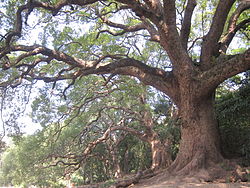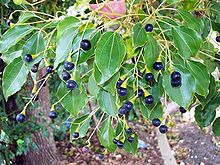Cinnamomum camphora (commonly known as camphor tree, camphorwood or camphor laurel) is a large evergreen tree that grows up to 20–30 m (66–98 ft) tall. The leaves have a glossy, waxy appearance and smell of camphor when crushed. In spring, it produces bright green foliage with masses of small white flowers. It produces clusters of black, berry-like fruit around 1 cm (0.39 in) in diameter. Its pale bark is very rough and fissured vertically.
Cinnamomum camphora is native to China south of the Yangtze River, Taiwan, southern Japan, Korea, and Vietnam, and has been introduced to many other countries.

In Japan, where the tree is called kusunoki, five camphor trees are known with a trunk circumference above 20 m, with the largest individual, Kamō no Ōkusu(蒲生の大楠, "Great camphor of Kamō"), reaching 24.22 m.
Camphor
Camphor is a white crystalline substance, obtained from the tree C. camphora. Camphor has been used for many centuries as a culinary spice, a component of incense, and as a medicine. It is also an insect repellent and a flea-killing substance.
C. camphora is native to Jeju off the coast of Korea, Taiwan, southern Japan, southeast China, and Indochina, where it is also cultivated for camphor and timber production. The production and shipment of camphor, in a solid, waxy form, was a major industry in Taiwan prior to and during the Japanese colonial era (1895–1945). It was used medicinally and was also an important ingredient in the production of smokeless gunpowder and celluloid. Primitive stills were set up in the mountainous areas in which the tree is usually found. The wood was chipped; these chips were steamed in a retort, allowing the camphor to crystallize on the inside of a crystallization box, after the vapour had passed through a cooling chamber. It was then scraped off and packed out to government-run factories for processing and sale. Camphor was one of the most lucrative of several important government monopolies under the Japanese.
Invasive species
In Australia
In the United States

Introduced to the contiguous United States around 1875, C. camphora has become naturalized in portions of Alabama, California, Florida, Georgia, Hawaii, Louisiana, Mississippi, North Carolina, Texas, and South Carolina. It has been declared a category I invasive species in Florida.
Insect herbivores
In Australia, two native Lepidoptera insects, the purple brown-eye and common red-eye, larval stages feed on camphor despite it being an introduced plant.
Source: Wikipedia

 Tiếng Việt
Tiếng Việt





